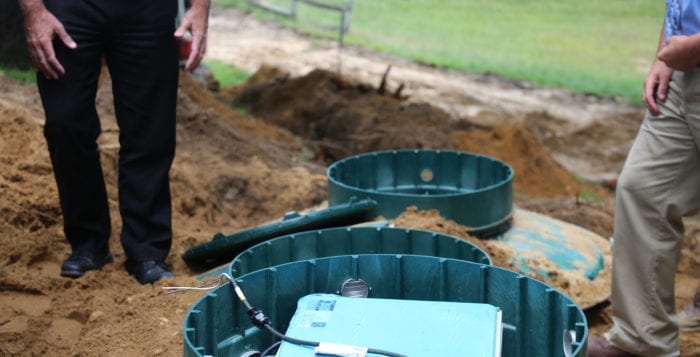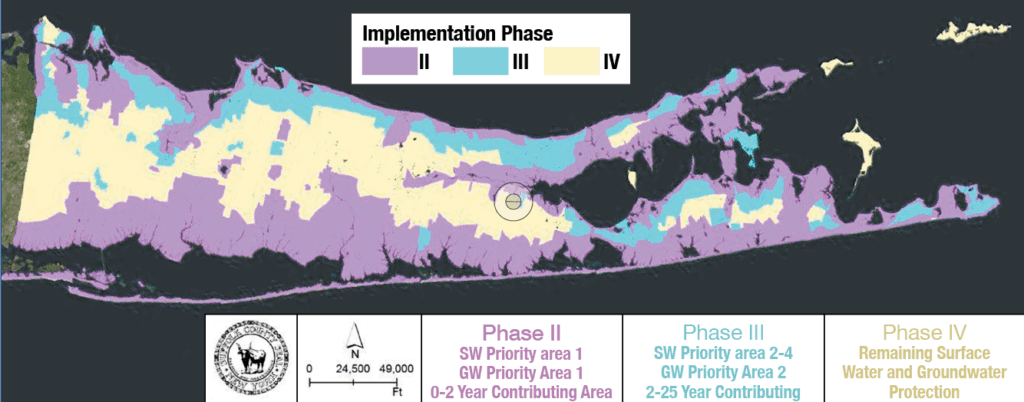Suffolk unveils ambitious plan aimed at combating nitrogen pollution

Suffolk County will look to address the ongoing issue of nitrogen pollution in surface and groundwater with an ambitious plan that will look to transition away from the reliance on cesspools and septic systems.
The Subwatersheds Wastewater Plan, which would invest $4 billion to combat nitrogen pollution, would last more than 50 years and sets a blueprint for the county to replace hundreds of thousands of old and inadequate septic systems.

The plan sets a goal for the county to eliminate 253,000 cesspools and septic systems by replacing them with new nitrogen reducing systems or by connecting them to existing sewers. According to Suffolk health officials, approximately 74 percent of the county remains unsewered, so individual residences and businesses rely on antiquated onsite wastewater disposal systems. Studies show that about 70 percent of the nitrogen input to local bays comes from approximately 360,000 cesspools and septic systems.
“Scientists have warned that continued reliance on primitive wastewater disposal systems is a mounting threat to both our environment and our economy,” said Dr. James Tomarken, Suffolk health commissioner. “Now, for the first time, there is a long-term plan to diminish nitrogen pollution and put Suffolk County on a path to cleaner, healthier water resources.”
The SWP has highlighted more than 190 individual watershed areas in Suffolk County and established goals and recommendations for reducing nitrogen inputs into each area. If those goals are met, health officials said it will begin to reverse the decline in water quality within 10 years and bring it back to a more pristine condition.
To get that process started, officials said the county will use more than $500 million in already allocated grant sources toward the replacement of 10,000 cesspools and septic systems and expand connections to sewer systems over the next four years as part of the first phase of the plan.
“This plan represents the first meaningful strategy to address legacy septic nitrogen pollution since countywide sewering objectives were abandoned some four decades ago,” Walter Dawydiak, director of Environmental Quality for Suffolk County, said. “In those four decades, we learned a great deal about how toxic excess nitrogen is to the ecosystem. However, we consistently failed to solve the single largest environmental health problems of our generation. Finally, we have a response plan that will restore our ecosystems and protect our drinking water.”
In the second phase of the plan, which would begin 2024, the county would look to eliminate more than 177,000 cesspools and septic systems near shorelines and high priority areas. It also recommends a requirement that cesspools and septic systems be replaced with new technology when properties change hands, or when those cesspools and septic systems fail. Officials estimate that the requirement could increase the number of cesspools eliminated from 1,000 to more than 5,000 per year.
The third phase of the SWP will tackle all other priority areas during a 15-year period. The fourth and final phase would address the remaining areas of the county beginning in 2068.
Currently, county grants of up to $20,000 are available for residents who qualify and wish to replace their cesspool. There is also an additional state grant of up to $10,000, which can mean a total of up to $30,000. As of July 1, Suffolk County residents who voluntarily decide to replace their cesspools will need to replace them with a system consisting of a septic tank and leaching pool at a minimum, according to previous reporting by TBR News Media. Contractors will need to register the system with the Department of Health Services.
The SWP will undergo a detailed review by the county’s Council on Environmental Quality and will include an environmental impact statement which is expected sometime in mid-August, according to officials. From there, a 30-day comment period will begin, with two public hearings being scheduled.






